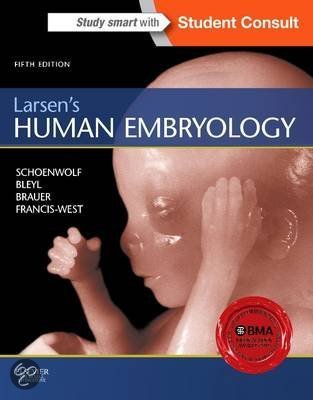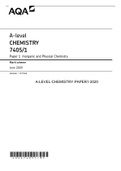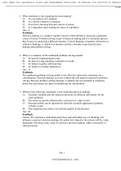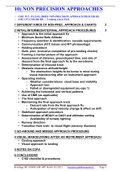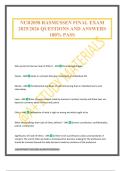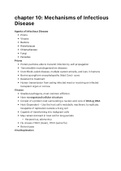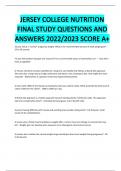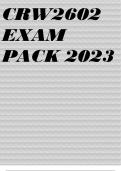Aantekeningen Humane Ontwikkeling Deel 1
Ch. 28 (Martnii – The reproductie system (part 1, malei
Gonads = organs that produce gametes and hormones.
Ducts = receive and transport gametes.
Accessory glands = secrete fuids into ducts.
Perineal structures = collectvely known as external genitalia.
Sides and sectons:
- Cranial/superior = hoofdzijde.
- Dorsal/posterior = rugzijde.
- Ventral/anterior = buikzijde.
- Caudal/inferior = onderzijde.
Brain, Hormones and Male Reproductie system:
Hypothalamus releases gonadotropin-releasing hormone (GnRH) to anterior pituitary
(hypofyse). The pituitary can releases adrenocortcotropic hormone (ACTH) to adrenal
glands which releases testosterone to testes, and the pituitary can release gonadotropic
hormones (FSH + LH) which also stmulates testosterone release in testes.
Male reproductie system:
- Pathway: Spermatoxoa travel form tests within epididymis, to ductus deferens, to
ejaculatory duct and penile urethra. Fluids are secreted from seminal iesicles, to
prostate gland, and the bulbourethal glands (Cowper).
- Spermatozoa deielopment require temperatures -1.1 °C lower than normal body
temperature, this is why the tests are not inside body. The cremaster and dartos
muscles relax/contract to regulate temperature.
- Inguinal canals are passageways through abdominal musculature for testes descent,
these are closed later in life. There is a risk of inguinal hernia.
Gonads: in testes the gametes and hormones are produced.
- Structure: the seminiferous tubules is the spermatozoa producton and then goes via
rete tests to ependymis, the connectie tssue supports blood and lymphatc vessels
and drains the efferent ductules which transport spermatozoa to ependymis.
- Deielopment by spermatogenesis, alongside sustentacular cells:
1. Spermatogonia: they divide by mitosis and one of them (asymmetric cell division)
proceeds, are diploid; occurs throughout adult life.
2. Primary spermatocytes: cell after mitosis they proceid by meisosis (symmetric),
diploid
3. Secondary spermatocytes: cell between meiosis I and meiosis II, differentate into
spermatds (= immature gametes).
4. Spermatds: after meiosis II, haploid.
5. Spermatozoa: after spermiogenesis (= differentaton from spermatds into
spermatozoa), spermatozoa has lost cytoplasm by phagocytose shed froms
1
, sustentacular cells end provide nutrients (= cytodifferentaton), and Golgi +
peroxisome have fused together to form acrosomal cap and it contains degrading
enzymes, it loses contact with wall of seminiferous tubule and enter fuid in lumen.
- Loss of organelles: After spermatogenesis the mature spermatozoon lacks endoplasmic
retculum, Golgi apparatus, lysosomes, peroxisomes, inclusions and other intracellular
structures. The reason is to reduce sperm size and mass. Sperm must absorb nutrients
(fructose) from surrounding fuid.
- Anatomy of spermatozoon:
Head: contains nucleus and chromosomes, acrosomal cap at tp of head
(compartment, contains enzymes essental to fertlizaton).
Neck: contains centrioles, anterior: mitotc spindle and posterior: contnuous
microtubules for movement of fagellum.
Middle piece: contains mitochondria for energy, is from original spermatd.
Tail: is whip-like organelle, moves cell, has complex corkscrew moton.
- 6 Major functons Sustentacular cells:
1. Maintain blood-tests barrier: isolates seminiferous tubules form immune system,
the sustentacular cells are joined by tght junctons and
2. Support mitosis and meiosis: the sustentacular cell is stmulated by FSH and
testosterone, this promotes division of spermatogonia thus the meiotc diiision of
spermatocytes; intersttal cells are stmulated by LH and this promotes them to
produce testosterone, promote male sexual characteristcs and inhibit hypothalamus
in releasing GnRH.
3. Support spermiogenesis: surround and enfold spermatds and phagocytze cytoplasm
shed by developing spermatds, the cells also provide nutrients and chemical stmuli.
4. Secrete inhibin: secreted by sustentacular cells in response to factors released by
spermatozoa, depresses pituitary producton of FSH/hypothalamic secreton of GnRH
5. Secrete androgen-binding protein: binds androgens in seminiferous tubule fuid,
important in elevatng androgen in seminiferous tubules, secreton is stmulated by
FSH via sustentacular cells.
6. Secrete Müllerian-inhibitng factor -> later meer
- Hormones and male reproductie functon:
GnRH = gonadotropin releasing hormone.
FSH = follicle stmulatng hormone; targets sustentacular cells to promote
spermatogenesis, causes secreton of androgen binding protein and inhibin.
LH = leutnizing hormone; causes secreton of testosterone and other androgens.
Inhibin: inhibits FSH producton, suppresses GnRH secreton, and speeds up sperm
development.
Androgen binding protein (ABP): prompts spermatogenic cells to bind to and
concentrate testosterone, this stmulates spermatogenesis.
-> Testes produced physically mature spermatozoa that can not fertlize oocyte.
Ducts of transport: vas deferens; these parts of reproductve system are responsible for
functonal maturaton, nourishment, storage and transport; the spermcells are incapable of
locomoton or fertlizaton and are moved by clia lining efferent ductules (epididymis).
- Functons epididymis: monitors/adjusts fuid produced by seminiferous tubules, recycles
damaged spermatozoa, and stores/protects spermatozoa untl use (facilitates functonal
maturaton by additon specifc proteins necessary fertlizaton).
2
, - Capacitaton in two steps:
1. Spermatozoa become motle when mixed with secretons of seminal iesicles.
2. Spermatozoa become capable of fertlizaton when exposed to female reproductie
tract; then destabilizaton of acrosome due to proteolytc and glycosidasic enzymes
and remoial of steroids by sterol binding proteins; they become more motle.
In uterus sperm is demolished by leucocytes, but isthmus (c) functons as sperm
store.
Non-identfed chemostatc cues (egg) regulate increase [Ca2+]. The attached
sperm have now low [Ca2+] (maintains longevity and functon) and detached
sperm have high [Ca2+] (enables more vigorous motlity, fagellum).
Loss of membrane cholesterol is vital for sperm to fertlize egg. During passage to
uterus, albumin and high-density lipoproteins act as cholesterol acceptors. But
these are washed off. Many glycolphosatdylinositol (GPI)-anchored proteins
(that are inhibitors of sperm-egg binding) are lost from membrane by tests-
specifc isozyme of angiotensin coniertng enzyme (ACE), because ACE cleaies
GPI-anchored proteins form sperm membrane.
Accessory organs: for fuid producton; the male glands actiate spermatozoa, provide
nutrients for spermatozoa (for motlity), propel spermatozoa and fuids along reproductve
tract (mainly by peristaltc contractons), and produce buffers to counteract acidity of
urethral and vaginal environments.
- Seminal fuid: mixture of secretons from three glands, with each distnctve biochemical
characteristcs, typical ejaculate 2-5 ml.
Seminal iesicles: actve secretory gland, contributes -60% of total volume, secreton
contains fructose/prostaglandins/fbrinogen.
Prostate gland: secretes acidic prostate fuid, prostatc acid-phoshatase (PAP) and
prostate-specifc antgen (PSA).
3
Ch. 28 (Martnii – The reproductie system (part 1, malei
Gonads = organs that produce gametes and hormones.
Ducts = receive and transport gametes.
Accessory glands = secrete fuids into ducts.
Perineal structures = collectvely known as external genitalia.
Sides and sectons:
- Cranial/superior = hoofdzijde.
- Dorsal/posterior = rugzijde.
- Ventral/anterior = buikzijde.
- Caudal/inferior = onderzijde.
Brain, Hormones and Male Reproductie system:
Hypothalamus releases gonadotropin-releasing hormone (GnRH) to anterior pituitary
(hypofyse). The pituitary can releases adrenocortcotropic hormone (ACTH) to adrenal
glands which releases testosterone to testes, and the pituitary can release gonadotropic
hormones (FSH + LH) which also stmulates testosterone release in testes.
Male reproductie system:
- Pathway: Spermatoxoa travel form tests within epididymis, to ductus deferens, to
ejaculatory duct and penile urethra. Fluids are secreted from seminal iesicles, to
prostate gland, and the bulbourethal glands (Cowper).
- Spermatozoa deielopment require temperatures -1.1 °C lower than normal body
temperature, this is why the tests are not inside body. The cremaster and dartos
muscles relax/contract to regulate temperature.
- Inguinal canals are passageways through abdominal musculature for testes descent,
these are closed later in life. There is a risk of inguinal hernia.
Gonads: in testes the gametes and hormones are produced.
- Structure: the seminiferous tubules is the spermatozoa producton and then goes via
rete tests to ependymis, the connectie tssue supports blood and lymphatc vessels
and drains the efferent ductules which transport spermatozoa to ependymis.
- Deielopment by spermatogenesis, alongside sustentacular cells:
1. Spermatogonia: they divide by mitosis and one of them (asymmetric cell division)
proceeds, are diploid; occurs throughout adult life.
2. Primary spermatocytes: cell after mitosis they proceid by meisosis (symmetric),
diploid
3. Secondary spermatocytes: cell between meiosis I and meiosis II, differentate into
spermatds (= immature gametes).
4. Spermatds: after meiosis II, haploid.
5. Spermatozoa: after spermiogenesis (= differentaton from spermatds into
spermatozoa), spermatozoa has lost cytoplasm by phagocytose shed froms
1
, sustentacular cells end provide nutrients (= cytodifferentaton), and Golgi +
peroxisome have fused together to form acrosomal cap and it contains degrading
enzymes, it loses contact with wall of seminiferous tubule and enter fuid in lumen.
- Loss of organelles: After spermatogenesis the mature spermatozoon lacks endoplasmic
retculum, Golgi apparatus, lysosomes, peroxisomes, inclusions and other intracellular
structures. The reason is to reduce sperm size and mass. Sperm must absorb nutrients
(fructose) from surrounding fuid.
- Anatomy of spermatozoon:
Head: contains nucleus and chromosomes, acrosomal cap at tp of head
(compartment, contains enzymes essental to fertlizaton).
Neck: contains centrioles, anterior: mitotc spindle and posterior: contnuous
microtubules for movement of fagellum.
Middle piece: contains mitochondria for energy, is from original spermatd.
Tail: is whip-like organelle, moves cell, has complex corkscrew moton.
- 6 Major functons Sustentacular cells:
1. Maintain blood-tests barrier: isolates seminiferous tubules form immune system,
the sustentacular cells are joined by tght junctons and
2. Support mitosis and meiosis: the sustentacular cell is stmulated by FSH and
testosterone, this promotes division of spermatogonia thus the meiotc diiision of
spermatocytes; intersttal cells are stmulated by LH and this promotes them to
produce testosterone, promote male sexual characteristcs and inhibit hypothalamus
in releasing GnRH.
3. Support spermiogenesis: surround and enfold spermatds and phagocytze cytoplasm
shed by developing spermatds, the cells also provide nutrients and chemical stmuli.
4. Secrete inhibin: secreted by sustentacular cells in response to factors released by
spermatozoa, depresses pituitary producton of FSH/hypothalamic secreton of GnRH
5. Secrete androgen-binding protein: binds androgens in seminiferous tubule fuid,
important in elevatng androgen in seminiferous tubules, secreton is stmulated by
FSH via sustentacular cells.
6. Secrete Müllerian-inhibitng factor -> later meer
- Hormones and male reproductie functon:
GnRH = gonadotropin releasing hormone.
FSH = follicle stmulatng hormone; targets sustentacular cells to promote
spermatogenesis, causes secreton of androgen binding protein and inhibin.
LH = leutnizing hormone; causes secreton of testosterone and other androgens.
Inhibin: inhibits FSH producton, suppresses GnRH secreton, and speeds up sperm
development.
Androgen binding protein (ABP): prompts spermatogenic cells to bind to and
concentrate testosterone, this stmulates spermatogenesis.
-> Testes produced physically mature spermatozoa that can not fertlize oocyte.
Ducts of transport: vas deferens; these parts of reproductve system are responsible for
functonal maturaton, nourishment, storage and transport; the spermcells are incapable of
locomoton or fertlizaton and are moved by clia lining efferent ductules (epididymis).
- Functons epididymis: monitors/adjusts fuid produced by seminiferous tubules, recycles
damaged spermatozoa, and stores/protects spermatozoa untl use (facilitates functonal
maturaton by additon specifc proteins necessary fertlizaton).
2
, - Capacitaton in two steps:
1. Spermatozoa become motle when mixed with secretons of seminal iesicles.
2. Spermatozoa become capable of fertlizaton when exposed to female reproductie
tract; then destabilizaton of acrosome due to proteolytc and glycosidasic enzymes
and remoial of steroids by sterol binding proteins; they become more motle.
In uterus sperm is demolished by leucocytes, but isthmus (c) functons as sperm
store.
Non-identfed chemostatc cues (egg) regulate increase [Ca2+]. The attached
sperm have now low [Ca2+] (maintains longevity and functon) and detached
sperm have high [Ca2+] (enables more vigorous motlity, fagellum).
Loss of membrane cholesterol is vital for sperm to fertlize egg. During passage to
uterus, albumin and high-density lipoproteins act as cholesterol acceptors. But
these are washed off. Many glycolphosatdylinositol (GPI)-anchored proteins
(that are inhibitors of sperm-egg binding) are lost from membrane by tests-
specifc isozyme of angiotensin coniertng enzyme (ACE), because ACE cleaies
GPI-anchored proteins form sperm membrane.
Accessory organs: for fuid producton; the male glands actiate spermatozoa, provide
nutrients for spermatozoa (for motlity), propel spermatozoa and fuids along reproductve
tract (mainly by peristaltc contractons), and produce buffers to counteract acidity of
urethral and vaginal environments.
- Seminal fuid: mixture of secretons from three glands, with each distnctve biochemical
characteristcs, typical ejaculate 2-5 ml.
Seminal iesicles: actve secretory gland, contributes -60% of total volume, secreton
contains fructose/prostaglandins/fbrinogen.
Prostate gland: secretes acidic prostate fuid, prostatc acid-phoshatase (PAP) and
prostate-specifc antgen (PSA).
3

